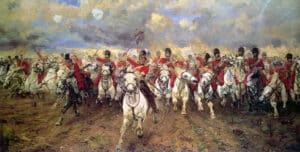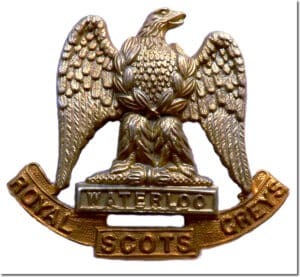Scots Greys Cavalry
Posted by Charles MacGregor on Sep 24th 2018
Written for The Celtic Croft by Charles MacGregor of MacGregor Historic Games.
Alleged corn/maize carvings in Rosslyn Chapel
I've previously discussed the claim that Henry Sinclair sailed to the New World in the 1300's. The Archaeological Fantasies Podcast discussed "-the supposed pre-contact images of New World maize in places like Rosslyn Chapel and ancient temples around the world. What do these images actually look like, is it really depictions of New World corn, and if it’s not corn, what is it?"
You can listen to the episode here.
Scots Greys Cavalry
Most people, when they think of Highland soldiers think of the kilted infantry regiments, but The Royal Scots Dragoon Guards are Scotland's senior regiment and her only regular cavalry. The history of the Royal Scots Dragoon Guards is the record of 3 ancient regiments and, through the Royal Scots Greys; they can claim to be the oldest surviving Cavalry of the Line regiment in the British Army. The Regiment in its current state was formed in 1971 from the union of two famous regiments, the 3rd Carabiniers and the Royal Scots Greys. The 3rd Carabiniers had themselves been constituted in 1922 from the amalgamation of the old 3rd Dragoon Guards and the Carabiniers (6th Dragoon Guards).
With the other British cavalry regiments, they now form part of the Royal Armoured Corps and, although horses have been replaced by tanks and other armored vehicles, it is the cavalry spirit of the past which continues to provide inspiration.
The regiment's history began in 1678, when three independent troops of Scots dragoons were raised. In 1681 these troops were regimented as The Royal Regiment of Scots Dragoons, or "The 4th Dragoons" in 1694. They were already mounted on grey horses by this stage and were being referred to as the Grey Dragoons. Prior to 1693, there is no record that the regiment used exclusively grey horses to others. However, when inspected in London in 1693 by King William III, people noted that the regiment was mounted on all grey horses. Some have offered the theory that the grey horses originated with the Dutch Horse Guards who may have turned their horses over to the Scots Greys when they returned to the Netherlands.
In 1707 they were renamed The Royal North British Dragoons (At that time "North Britain" was being envisaged as a common name for Scotland), but were already being referred to as the Scots Greys. In 1713 they were renumbered the 2nd Dragoons, as part of a deal between the establishments of the English Army and Scottish Army when they were being unified into the British Army. Throughout the 1700's they served in a number of wars, The War of the Spanish Succession, the 1715 Jacobite rebellion, War of Austrian Succession, and the Seven Years' War.
Between 1764 and 1815, the Scots Greys remained on home service. Unlike many of the other regiments of British cavalry, they did not see any combat during the American Revolutionary War or during any of the British campaigns during the French Revolutionary or Napoleonic Wars. In fact, for most of the 20 years following the Seven Years' War, the Scots Greys remained in Scotland and England.

One of the regiment's most famous episodes was at the Battle of Waterloo in the spring of 1815, when a Sergeant Charles Ewart captured the Imperial Eagle standard of Napoleon's 45th Regiment, going on to receive a commission given by the Prince Regent. The Commanding Officer in this battle was last seen alive with both his wrists slashed, holding the reins in his teeth charging towards the French Artillery batteries.
Napoleon himself was overheard referring to the Scots Greys as "Those terrible Grey Horses" and their charge has since been described as the greatest thunderbolt ever launched by the British Cavalry. To this day an eagle commemorating the one captured at Waterloo is part of the Regiment's cap badge:

One of the regiment's most dramatic episodes was the "Charge of the Heavy Brigade" -as opposed to the "Charge of the Light Brigade" at the same battle. During the Crimean War at the Battle of Balaclava the Scots Greys and the rest of the British dragoons totaling about 800 charged uphill into 3000 Russian Cavalry in a battle that has been described as one of the most desperate but successful cavalry versus cavalry charges in history. The Charge of the Heavy Brigade lasted no more than 10 minutes, and resulted in the Russian cavalry suffering 40 to 50 killed and over 200 wounded, and the British losing only 10 killed and 98 wounded.
By WWI they were still on horseback, but fought primarily on foot through most of the war. Their distinctive grey horses were dyed dark chestnut to make them less conspicuous targets, and for fear their all grey mounts would make the regiment distinctive and therefore easier to identify for enemy intelligence. It was finally in 1940 that the unit was mechanized as a motorized cavalry regiment, and the dragoons were retrained to act as drivers, loaders, and gunners for tanks. Designated as an armored regiment, they received their first tanks in September 1941.

